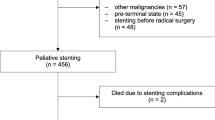A 71-year-old man developed pyloric stenosis caused by gastric cancer. Vomiting and nausea resolved after the insertion of an uncovered Ultraflex stent (length 10 cm, inner diameter 18û23 mm) through a 7-cm-long stenosis, and the patient was able to eat a soft diet. After 6 weeks, stent occlusion occurred due to tumor ingrowth and accumulation of food residue. Endoscopic observation showed a very narrow residual lumen. A covered Ultraflex stent (length 10 cm, inner diameter 18û23 mm) was inserted through the first stent and expanded to its maximum diameter over the next 2 days. The patient's vomiting and nausea improved rapidly. He died 6 months after the second stenting procedure, from metastatic tumor spread, having remained free of nausea and vomiting. In this case, a covered metallic stent prevented tumor ingrowth and maintained gastrointestinal patency.
Similar content being viewed by others
Author information
Authors and Affiliations
Rights and permissions
About this article
Cite this article
Nakamura, T., Kitagawa, M., Takehira, Y. et al. Palliation of Pyloric Stenosis Caused by Gastric Cancer Using an Endoscopically Placed Covered Ultraflex Stent: Covered Stent Inside an Occluded Uncovered Stent . Cardiovasc Intervent Radiol 23, 315–317 (2000). https://doi.org/10.1007/s002700010078
Published:
Issue Date:
DOI: https://doi.org/10.1007/s002700010078




